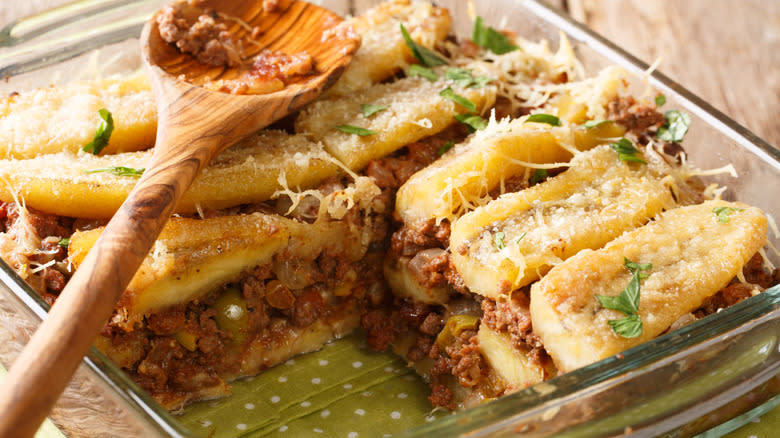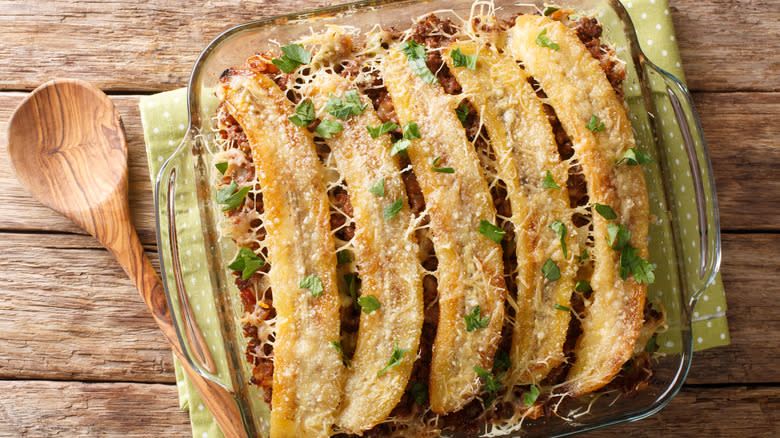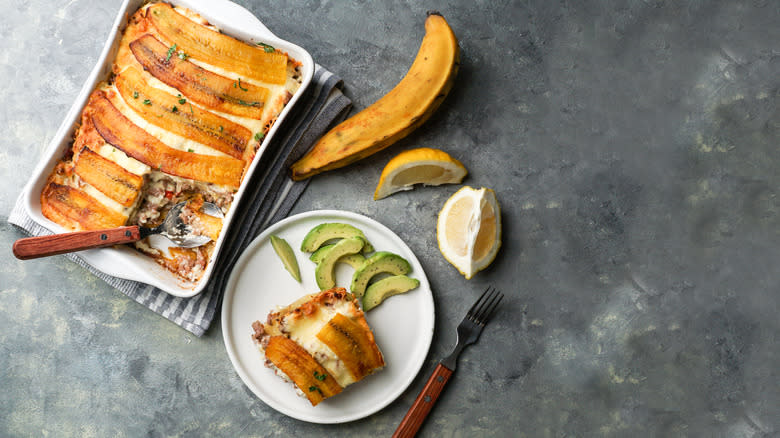Pastelón Is The Puerto Rican Plantain Casserole You Should Know

Nothing beats a casserole in its malleability. This dish style integrates a variety of tastes and textures, all served in one pan to share. And whether it's squash or green beans, it's easy to accommodate a variable constituent base.
In Puerto Rico, plantains are utilized in a casserole known as pastelón. Split into layers with aromatic ground beef nestled in between, the dish resembles a Caribbean-influenced lasagne. Loaded with spices, the soft fruit melds delectably with the aromatic browned meat. And it's garnished off with melted cheese on top and an egg wash to tie it together.
The dish does require some prep work; the plantains are pre-fried, and the ground beef is cooked into an aromatic picadillo. However, the efforts are more than worthwhile. Once baked, all the flavors blend into a delicious medley of taste and texture -- a casserole at its best.
Read more: 35 Popular Puerto Rican Foods You Have To Try At Least Once
A Culinary Representation Of The Puerto Rican Diaspora

Pastelón is most strongly interlinked with Puerto Rico. However, various renditions are consumed across the Caribbean. It's especially popular in the Dominican Republic, where the plantains are boiled instead of fried. The dish itself is relatively young, only first mentioned in a cookbook in 1948. And its resemblance to lasagne is more than coincidence; many consider New York City to be its birthplace. It's likely the Puerto Rican diaspora was inspired by the Italian-American classic and substituted in local ingredients. From there, it was carried back to the island and popularized within the territory.
Today, pastelón has become a traditional dish in the island's cuisine. Like other casseroles, it's a heart-warming and convivial dish shared in the family. Its comforting ingredients are easy to substitute, and the dish can remain warm in the oven while the sides are prepared.
How Pastelón Is Prepared

Pastelón is founded upon plantains; they're indispensable to the dish. It's necessary to use a ripe variant of the fruit, since they'll have a softer consistency and sweeter taste, which melds better into the casserole. Between the layers of plantain, there's a dependable mixture of picadillo -- a mixture of ground beef, peppers, onions, and seasonings. And a beaten egg wash binds the dish together. When it comes to flavorings, pepper-bases adobo seasoning adds a bright kick, and there's a dash of classic Puerto Rican sazón.
Preparation starts with the frying of plantains. The fruit is peeled and cut lengthwise into thin strips. They're then fried in vegetable oil until golden brown and slightly crisp. Next is the assembly of the picadillo. Techniques vary; some assemble a pepper, onion, and garlic-based sofrito, which is sautéed, and then the meat is introduced. Others start by browning the beef, and then integrating the aromatics and spices in the oil. Tomato sauce melds the mixture to completion, and some add olives or capers for a tang.
Finally comes the casserole assembly. The plantains are layered on the bottom of the pan, with the picadillo placed on top. There's an optional garnishing of cheese -- often mozzarella -- before another layer of plantains, followed by meat, cheese, and more sliced fruit on top. The casserole's covered in beaten eggs, and there's a final sprinkling of cheese. Pastelón bakes for 25 minutes at 350 degrees Fahrenheit.
Read the original article on Tasting Table.

